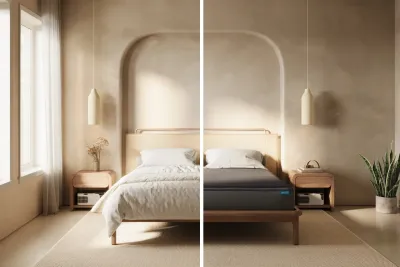The Best Bed Sleeping Positions for Your Health and Sleep Quality
Chilipad Editorial Team • May 12, 2025

Key Takeaways
- Side Benefits: Sleeping on your side—especially the left—can improve digestion, less snoring, and ease heartburn.
- Back Support: Back sleeping promotes spinal alignment but may increase snoring or worsen sleep apnea.
- Stomach Struggles: Stomach sleeping may ease snoring but strains your neck and spine.
- Position Preference: Your best sleep position depends on age, health needs, and comfort—there’s no one-size-fits-all.
- Cooler Comfort: No matter your go-to position, the Chilipad keeps your bed cool and optimal all night.
Getting restful sleep and maintaining proper sleep posture is important for maintaining overall health and quality of life. However, many people don’t realize that their sleep position can significantly influence how well they rest. From easing back pain to minimizing snoring, the way you sleep can directly impact how your body feels when you wake up.
This article takes a closer look at the best sleeping positions, such as sleeping on your back, side, or stomach, and explains how each one affects your comfort, physical alignment, and overall quality of sleep.
You’ll also find helpful guidance on how to determine the best sleeping position that may be best suited to your specific needs, so you can wake up feeling refreshed, pain-free, and ready for the day ahead.
Save Up to 20% - Custom Comfort for Every Sleeper
Save now and upgrade your sleep. Side sleeper, back sleeper, stomach sleeper—no matter the common sleep position, the Chilipad keeps your bed at the perfect temperature from cool to warm, anywhere between 55°F and 115°F.
Match Your Sleep Position to Your Aches: Tips for Common Pain Points
| Concern | Positoins to Try | Sleep Tips |
|---|---|---|
| Lower Back Pain | Side, Fetal, Back | When side sleeping, place a pillow between your kness to keep your spine aligned. |
| Neck Pain | Back, Side | Use a firm pillow for side sleeping and a thinner one for back sleeping to reduce strain. |
| Snoring & Sleep Apnea | Side, Feta, Stomach | If you're a stomach sleeper, slide a pillow under your hips and keep your head pillow flat. |
| Acid Reflux | Left Side | Sleeping on your left side can help reduce nighttime reflux better than the right. |
| Pregnancy | Fetal, Side | A body pillow or wedge can work wonders for extra support and pressure relief. |
| Sinus Congestion | Back | Elevate your head with an extra pillow to help with drainage and easier breathing. |
| Hip or Knee Pain | Back | Put a pillow under your knees to take the pressure off your hip and spine. |
Fetal Position
Curling your legs in toward your chest while sleeping on your side is one of the most popular and naturally adopted sleep positions. Often described as the fetal position, it’s especially common among women and provides a sense of comfort and security that many find soothing.
Roughly 41% to 47% of people curl up in the fetal position at night—making it the most popular sleep position. It's cozy, compact, and instinctual, it’s the go-to for nearly half the population.
This position can ease tension, support spinal health, and offer targeted relief for certain conditions when practiced with proper alignment and support. Sleeping on your side tends to become increasingly preferred with age, offering greater comfort and support as the body’s needs change over time.
Here are some of the key benefits of sleeping in this curled-up posture:
- Reduce Lower Back Pain: Curling up can help open up the spaces between the vertebrae, easing pressure on the spine and relieving discomfort in the lower back.
- Comfort During Pregnancy: This position, particularly on the left side, increases circulation and reduces pressure on the uterus, making it a top pick for pregnant women.
- Eases Symptoms of Certain Conditions: This curled-up sleeping position can help reduce pressure on the spine and surrounding nerves, making it especially beneficial for those dealing with sciatica or herniated discs.
- Soothes Muscle Tension: This sleep style creates a sense of comfort and security that can help the body relax more fully. As tension melts away, the nervous system settles, making it easier to drift into deeper sleep.
- Tips for Fetal Sleepers: Maintain a relaxed posture to avoid restricting your breathing and allow your body to fully unwind. Placing a pillow between your knees and also between the arms can improve hip and spinal alignment and add extra comfort throughout the night.
Drawbacks of Fetal Position Include:
- Potential restriction of deep breathing
- Increased joint stiffness if curled too tightly
- Possible neck or back strain without optimal alignment
- Can aggravate existing arthritis or joint pain
- May contribute to facial wrinkles on the side pressed into the pillow
Side Sleeping
Side sleeping is the most common and widely preferred sleep position, with studies showing that over 60% of people naturally gravitate toward it. This is a comfotable position for most as it provides a variety of health advantages that can support better rest and overall physical comfort.
Whether you’re aiming to reduce pressure on your back, improve digestion, or minimize snoring, sleeping on your side can be highly beneficial. If you deal with gastroesophageal reflux disease (GERD), side sleeping might be your nighttime secret weapon for keeping symptoms in check.
Here are some of the key health benefits associated with side sleeping:
- Improves Spinal Alignment: When supported with the right mattress and pillow, side sleeping can help maintain a neutral spine position, reducing neck and back pain.
- Minimize Snoring & Symptoms of Sleep Apnea: Sleeping on your side helps keep the airway open, making breathing easier and potentially decreasing snoring and mild obstructive sleep apnea symptoms.
- Provides Comfort During Pregnancy: Pregnant women are often advised to sleep on their left side to improve blood flow to the fetus and reduce pressure on your organs.
- Promotes Healthy Digestion: Particularly when sleeping on the left side, this position can support better digestion and reduce issues including acid reflux and heartburn by aiding the natural movement of food and waste through the digestive tract.
- Eases Pressure on the Lower Back: Placing a pillow between slightly bent knees helps relieve tension in the lower spine, reducing pain and enhancing overall comfort during sleep.
- Supports Brain Health: Research suggests that sleeping on the side may improve the brain’s waste-clearing process, potentially contributing to long-term cognitive health.
- Enhances Circulation: This position can help improve blood flow, especially for pregnant individuals, by relieving pressure on key blood vessels.
Side sleeper? Use a supportive pillow to keep your neck in line with your spine, and tuck a pillow between your knees to keep everything aligned from top to bottom.
Drawbacks of Side-Sleepers Include:
- Potential for shoulder pain or hip pressure
- May lead to arm numbness or tingling
- Increased risk of wrinkles on the side of your face pressed against the pillow
- Potential spinal misalignment without proper mattress and pillow support
- Curling too tightly may restrict deep breathing
Sleep Study: Among individuals who reported pain in just one shoulder, 67% were found to be side sleepers.
Back Sleeping
Only about 1 in 10 adults sleep exclusively on their backs, making it the least common of the three main sleep positions—side, stomach, and back. Still, sleeping on your back ranks as the second most popular choice overall and is often praised for promoting spinal alignment and full-body support.
When done right, it can offer some serious health perks—even if most people don’t naturally do it. This sleeping position allows your head, neck, and spine to rest in a neutral, aligned posture, which can help prevent strain and neck pain and promote better overall support.
Back sleeping is great for evenly distributing weight across your body, helping to reduce pressure points and keep you aligned.
That said, it’s not for everyone—especially if you snore or struggle with sleep disorders like sleep apnea. But with the right pillow and mattress combo, back sleeping can be a smart, restorative choice.
Wondering what might be throwing off your sleep? Learn more about common sleep disorders and how to spot the signs.
Here are some of the** key benefits of sleeping on your back**:
- Spinal Support: Sleeping on your back promotes a balanced distribution of body weight, which helps keep your spine in a neutral, aligned position. This reduces unnecessary stress on your lower section of your back and neck, making it easier for your muscles to relax and recover overnight.
- Pain Relief: Back sleeping can help reduce neck and back pain, especially when paired with a pillow that keeps your spine aligned. It also spreads your body weight evenly, which takes pressure off your joints, making it a great option if you often wake up with sore hips or shoulders.
- Facial Skin Health: Unlike side or stomach sleeping, resting on your back keeps your face from pressing into the pillow, helping to minimize skin irritation, reduce breakouts, and lower the risk of developing sleep lines or facial sleep wrinkles over time.
- Eases Tension Headaches: When your head and neck are properly supported, your muscles can relax more fully during the night. This reduces the buildup of tension that often leads to headaches when you wake up.
- Improves Breathing for Some: Sleeping on your back with your head slightly elevated can help open up the airways and make nasal breathing easier throughout the night. However, this sleeping position may not be the best choice for heavy snorers or individuals with sleep apnea. If you have sleep apnea, it's usually best to avoid sleeping on your back.
- Ideal for Post-surgery Recovery: Sleeping on your back is often recommended after certain procedures because it helps keep your body in a stable, supported position. It also reduces pressure on sensitive or healing areas, which can promote a smoother recovery.
Tips for Back Sleepers: Use a medium-firm pillow that supports the natural curve of your neck. Additionally, placing a small pillow under your knees can relieve pain and tension located in the lowe section of your back.
Drawbacks of Back Sleeping include:
- Increased risk of snoring
- Potentially worsened symptoms of sleep apnea
- May lead to lower back discomfort without proper support
- Not ideal during late-stage pregnancy
- In those prone to it, back sleeping can cause acid reflux if the head isn’t elevated properly
Stomach Sleeping
Stomach sleeping is the least common of all sleep positions, with less than 10% of people naturally gravitating toward it. While it might feel liek a comfortable position to some and may even help minimize snoring by keeping airways open, this position is generally not recommended for long-term sleep health.
Did You Know: Sleeping on your chest and stomach—known as the prone position—is actually one of the least popular sleep styles out there.
It often puts extra pressure on the neck, spine, and internal organs, which can lead to discomfort or misalignment over time. However, for certain sleepers, it can offer a few specific advantages, especially when paired with the right support.
Here are a few potential benefits of sleeping on your stomach:
- Reduces Snoring: Sleeping on your stomach can help keep the upper airway open, which may minimize snoring for some people, especially compared to back sleeping.
- May Ease Mild Sleep Apnea Symptoms: By preventing the tongue and soft tissues from collapsing into the airway, this position might help reduce mild obstructive sleep apnea events.
- Can Feel Calming and Secure: For some stomach sleepers, lying face-down creates a grounded, secure sensation that promotes relaxation and a faster transition to sleep.
- Improves Digestion Positioning for Some: Although not universally recommended, certain people find temporary relief from digestive discomfort when sleeping on their stomach.
- Minimizes Tossing and Turning: Stomach sleepers often remain in a single position longer, which can lead to fewer disruptions during the night.
- Tips for Stomach Sleepers: If you prefer this position, use a very thin pillow or none at all to minimize neck strain. A firm mattress can also help maintain spinal alignment.
Drawbacks of Stomach Sleeping Include
You may want to avoid this sleeping position based on the following:
- Increased strain on the neck
- Poor spinal alignment
- Higher risk of back pain
- Pressure on organs
- Restricted breathing
- Greater chance of facial wrinkles or skin irritation
- Difficulty maintaining a neutral posture throughout the night
Finding Your Best Sleeping Position
Sleep positions aren’t one-size-fits-all—what works for one person might not work for another. Finding your ideal sleep setup often takes some trial and error. Keeping a sleep diary to track how you feel each morning—comfort level, restfulness, or any aches—can help spot useful patterns. And while switching positions might feel weird at first, the payoff in better sleep and less discomfort is totally worth it.
Curious about the different sleep styles and what they’re called? Check out our blog on the names of popular sleep positions to get familiar with the terms and what each one means.
Final Thought
Your sleeping position isn’t just about comfort—it’s a powerful player in how well you rest, how effectively your body recovers, and how energized you feel the next day. From easing joint pressure to supporting spinal alignment, the way you sleep impacts everything from posture to digestion.
While side and back sleeping are widely considered the most beneficial for most people, even stomach sleepers can make it work with proper pillow support and mindful positioning.
The key is tuning into your body. If you wake up sore, restless, or still tired, it might be time to re-evaluate your sleep posture. Try small changes like adjusting your pillow height, adding knee support, or gradually shifting your position throughout the night.
These adjustments can go a long way in helping you find the best sleeping position that promotes comfort, recovery, and long-term sleep quality. Because at the end of the day—or rather, night—better sleep starts with how (and where) you lay your head.
Frequently asked questions
Which is Considered the Most Comfortable Position?
That really depends on you. Comfort is personal. What feels amazing for one sleeper might be a nightmare for another. Side sleeping is the most popular, especially the fetal position, but others swear by back sleeping for spinal support or stomach sleeping for calming anxiety (even if it’s tough on the neck).
So, the most comfortable position is the one that helps you wake up feeling rested and pain-free.
What Is the Healthiest Sleeping Position?
Most experts agree that sleeping on your side, especially your left side, is generally best for digestion, circulation, and spinal alignment. Other sleeping positions are also a good option including on your back and in a fetal position.
How Can I Improve My Sleep Posture?
- Use a pillow that supports your neck and aligns with your sleep position
- Place a pillow between your knees if you’re a side sleeper
- Try a thin pillow under your hips for stomach sleeping
- Choose a mattress that’s firm enough to support your spine
- Track your comfort levels and make small adjustments over time
What Is the Best Position To Sleep as You Age?
As you age, the most popula sleep position tends to be side sleeping—particularly on your left—tends to be the top pick. It helps reduce snoring, eases acid reflux, and supports spinal alignment, which becomes more important as joints and muscles lose flexibility.
Bonus: It can also improve circulation and brain health thanks to better glymphatic drainage during sleep. Just be sure to pair it with a supportive pillow and mattress to stay comfy all night.
What’s the Best Mattress for Stomach Sleepers?
The best mattress for stomach sleepers is one that keeps your spine aligned without letting your hips sink too deep. Look for a medium-firm to firm mattress with solid support and just a touch of cushion for comfort. Too soft, and you’ll feel like a hammock; too hard, and your joints might protest. Bonus points if it includes cooling mattress topper, stomach sleepers tend to run hot.
What’s the Best Sleeping Style for Your Body?
It depends on your goals. On your side is an ideal sleeping posiotn as it's great for digestion and reducing snoring, back sleeping supports spinal alignment (but can worsen sleep apnea), and stomach sleeping… well, it’s tough on your neck and spine. Want the best combo? Side sleeping—especially on your left side—tends to be the MVP for most people.









